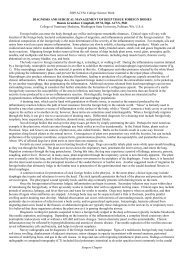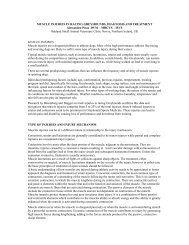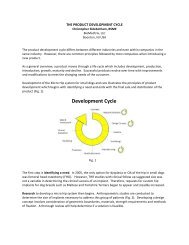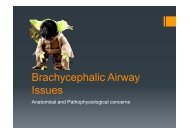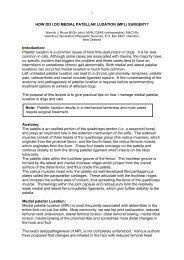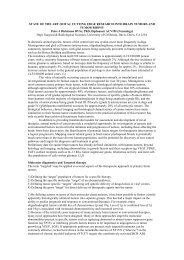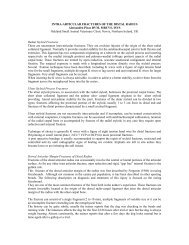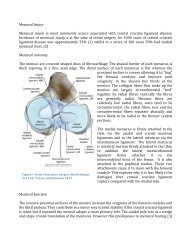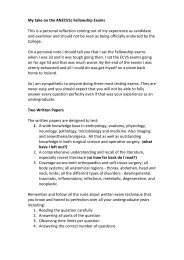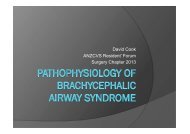Create successful ePaper yourself
Turn your PDF publications into a flip-book with our unique Google optimized e-Paper software.
TRIPLE LINEAR TIBIAL PLATEAU LEVELLING OSTEOTOMYAKA ‘TWATO’ (TIBIAL WEDGE AND TUBEROSITY OSTEOTOMY)K R Smith, FACVScVeterinary Specialist Services, Cnr Logan & Lexington Rds, Underwood, Qld, 4119Ph 0738417011, Facs 0738417022, email vss@vss.net.auTriple linear tibial plateau levelling osteoto<strong>my</strong> (TL-<strong>TPLO</strong>): is a novel osteoto<strong>my</strong> for the treatment ofcranial cruciate ligament (CrCL) rupture; one that does not have a patent and require a licence; and one thatdoes not require the acquisition of special instruments.Historically tibial wedge osteoto<strong>my</strong> (TWO) was first described by Slocum (1984), and then he developedhis <strong>TPLO</strong> based on a radial osteoto<strong>my</strong> of the proximal tibia which improved the function and outcome(Slocum 1993). The procedure was said to eliminate cranial tibial thrust without shortening the tibia.Slocum enterprises then offered courses, instrumentation & special plates to licensees, and despite theexpense, the courses were extremely popular as American surgeons searched for something that providedstifle stability & better return to athletic function. Bookings were so heavy that I was finally offered a placein one in 2001-02 after application in 1994. Slocum’s technique of radial osteoto<strong>my</strong> cannot be used in dogswith slopes of more than 40 degrees as caudal over-hang places significant pressure on the caudalmusculature that prevents further rotation & more rotation further isolates the tibial tubercle thatpredisposes it to fracture. More recently subsidence or “rock-back” has been recognized. This is a failure tomaintain the slope of the tibial plateau after reduction.The TWO failed to address the issues of tibial shortening with consequent effects on stifle biomechanics,patella function and strain on the straight patellar ligament. The straight stifle post-operatively predisposesto a “pivot-shift” gait and patellar luxation if limb alignment is not perfect. Subsidence was also recognizedas was change in leg function and a high incidence of screw loosening. These biomechanical and functionalproblems led me to develop the TL-<strong>TPLO</strong> in the mid 1990’s.Initially I used 6 and 7 hole 3.5 and broad 3.5 DCP plates to stabilise the osteoto<strong>my</strong>, then designed and hadVeterinary Instrumentation in the UK make the initial purpose designed T-plates. This plate was amodification of AO/ASIF distal radial T-plate, but was more substantial and had 3 holes proximally. Sincethat time the plate has been enlarged (broad 3.5), stretched (7 hole), miniaturised (2 and 2.7 sizes) as thedemand increased and surgeons realised that a range of breeds and sizes had large tibial plateau slopes thatcould be repaired by proximal tibial osteoto<strong>my</strong>.The TL-<strong>TPLO</strong> consists of 3 linear osteotomies - one to remove the tibial crest, the second to osteotomisethe tibia, the third to remove the desired wedge of bone.This technique is used as the primary method of stabilisation (biomechanical stabilisation) for dogs withtibial plateau angles > 20 degrees. These fall into four categories of CrCL disease,1. A chronic history of gradual or partial CrCL rupture2. Large breed dogs with an acute or chronic history of lameness and CrCL rupture3. Failed extra-articular stabilisation4. Dogs that have the tibia sitting in a cranial position when palpated for drawerAccurate measurement of the slope of the tibial plateau and cranio-caudal limb alignment is required. Fulllengthradiographs of tibia are needed. Good positioning of the patient is essential. The medio-lateral viewis taken with the uppermost hind-leg pulled forwards towards the elbow or moderately abducted ormoderately extended, to ensure superimposition of the femoral condyles. Care is taken to observe the distalfemur when positioning the upper rear leg as rotation can be detected on the various attempts atpositioning, especially if the upper leg is moved too far in the attempt to not obscure the lower tibia. Oneonly has to move the upper limb a few cm to allow good access to the lower tibia. Measurement of thetibial plateau angle on a rotated limb (condyles not well superimposed) will underestimate the tibial plateauangle. The caudo-cranial view is taken with the patient in ventral recumbency with the hind-leg extendedcaudally so that the stifle joint is not rotated. The aim should be to have the patella centered in the trochlear
groove on your Ca-Cr film. Tibial torsion then can be assessed by the position of the calcaneus relative tothe tarso-crural joint. The weight-bearing axis of the tibia is measured on the medio-lateral film. The distalpoint is the centre of the hock & can be determined two <strong>way</strong>s, 1, by concentric circle method over thelateral talar ridge, or 2, the centre of the distal tibia as measured from the most cranial and caudal points ofthe distal tibia on this lateral radiograph. The proximal point is the centre of the weight bearing tibialplateau, a point that bisects the points marking the centre of each of the two superimposed tibial eminenceson the lateral radiograph. These proximal and distal points are joined by a line, the weight bearing axis ofthe tibia. The most cranial and caudal points of the weight-bearing surface of the tibia are marked and a lineis drawn between the two points. This line represents the plateau slope when measured from a line drawnperpendicular to the weight bearing axis.Warzee et al (2001) suggested that the desired post-operative tibial plateau angle of 6.5 degrees adequatelyneutralises tibial thrust without overloading the caudal cruciate ligament. This is the angle we try to achieveafter a high tibial osteoto<strong>my</strong>. The size of the bone wedge to be removed is then calculated from the mediolateralfilm. From the point of intersection of the weight bearing axis and the tibial plateau angle lines, twofurther lines are marked. A third line is marked on the radiograph at 90 degrees to the tibial long axis and a4 th line an angle of 6.5 o to this perpendicular line. Points are marked every 0.5 or 1cm distances along this4th line, the line 6.5 o from perpendicular. Vertical measurements from these points to the line representingthe tibial plateau slope are recorded. They represent they vertical distance used to mark the cranial edge ofthe 3 rd osteoto<strong>my</strong> made during the procedure, ie. these vertical measurements are used to calculate thevertical length of the cranial aspect of the wedge to be removed. Mathematically this can be determinedfrom the formulah = w ( tan x – tan 6.5)h = length of bone to be removed at the cranial edge of the 3 rd osteoto<strong>my</strong>w = the width of the transverse osteoto<strong>my</strong> (the 2 nd osteoto<strong>my</strong>)x = the tibial plateau angle measure from the lateral radiographThis is available in table form (courtesy of Dr Alan Cross, Florida State University) which can be suppliedon request.The technique involves placing the dog in lateral recumbency with the affected leg uppermost. A medialparapatellar skin incision is made from the distal 1/3 of the femur to the proximal 1/3 of the tibia. This skinis reflected laterally to expose the lateral fascia, this incision is to allow a lateral arthroto<strong>my</strong>. Alternativelythe dog can be placed in dorsal or lateral recumbency to allow a medial skin incision & medial arthroto<strong>my</strong>.The choice of approach should be selected on familiarity and one that allows good intra-articular exposure.The joint is inspected, damaged ligament is removed. Undamaged, non-stretched ligament is left behind.Menisci are inspected; a hemimeniscecto<strong>my</strong> (removal of the damaged parts of the meniscus) is performedif indicated. When the caudal pole of the medial meniscus is detached from the caudal capsularattachments, it may be sutured back into place. I do not routinely perform a meniscial release. Thisprocedure that alters the “hoop-load” function (Miller 1998) of the meniscus, which in turn affects thecongruency and function of the stifle joint. The joint is lavaged, the capsule closed and a fascia lata overlapis performed. Medial arthroto<strong>my</strong> if performed is closed routinely in two layers. Fascia lata overlap willreduce the drawer and improve stability in the immediate post-operative period, and possibly help preventpost-operative meniscial damage.The dog is then rolled 180 degrees so that the affected leg is down most allowing a medial approach to theproximal tibia. The periosteum is elevated medially, caudally, laterally, the caudal and lateral aspects arepacked with dry swabs to protect the soft tissues particularly the popliteal artery that lies in the caudolateralborder of the tibia.A T-plate is contoured to fit the proximo-medial tibia. The bone is then scored in 3 positions.1. At the cranial edge of the plate when placed on the tibia. This marks the position of the osteoto<strong>my</strong>to remove the tibial crest.
2. The position of the transverse osteoto<strong>my</strong>.3. The cranio-distal aspect of the tibial crest. This mark is used to re-position the tibial crest so thatits relationship with the tibial diaphysis and the distal femur is not significantly altered whenreattached.The tibial crest osteoto<strong>my</strong> is carefully performed ensuring the straight patellar ligament is not inadvertentlydamaged. This osteoto<strong>my</strong> (osteoto<strong>my</strong> 1) is roughly parallel to the long axis of the tibia. The transverseosteoto<strong>my</strong> (osteoto<strong>my</strong> 2) of the proximal tibial metaphysis is completed. A hohmann retractor is placedcaudal to the tibia onto the pre-placed swab; medio-lateral pressure is applied to help retract the poplitealartery when transverse osteotomies are made. The width of bone (w) on the distal side of this osteoto<strong>my</strong> isread and the length of vertical osteoto<strong>my</strong> on the cranial aspect of the tibia (h) is deducted from theradiographic measurement or mathematical table. The vertical distance is marked on the tibial diaphysis,and the 3 rd osteoto<strong>my</strong> (osteoto<strong>my</strong> 3) from this point to the caudal aspect of the 2 nd osteoto<strong>my</strong> is performed.The wedge of bone with its cancellous medulla is wrapped in a blood soaked swab and placed in a safeposition so that it can be used as autogenous cancellous bone graft later.The tibia is then reduced. If difficulty is encountered I fracture the fibula by breaking open the medialaspect of the tibia over a fulcrum (thumb) at this point. This prevents a bowstring effect by the fibula,which makes reduction of the tibial osteoto<strong>my</strong> simpler.The plate is placed against the proximal tibia and at this point final bending adjustments are made ifnecessary. Longitudinal twisting of the plate can also be done at this point, to allow for outward rotation ofthe tibial diaphysis distal to the osteoto<strong>my</strong> to reduce tibial torsion if present. It is important to ensure avalgus tilt of the proximal tibia is prevented. This can be assessed by retraction of the tibial crest andassessment of alignment of the bone segments above and below the osteoto<strong>my</strong>. Further plate bending isdone to correct valgus mal-alignment if found. The proximal screw at the bottom of the T is the first placed.Once placed, the osteoto<strong>my</strong> is reduced & the position of the plate over the distal tibia is checked.Adjustments in trajectory are made prior to placing additional screws. All screw holes are then filled;cancellous screws are often used to fill proximal holes.A small hole is then drilled through the tibia distal to the osteoto<strong>my</strong> adjacent a solid section (not a hole) ofthe plate and a piece of 16-20-gauge (mostly 18) wire is placed through it. The tibial crest is thenreattached with two K-wires, generally 1.8 or 2mm. The wire is placed in figure eight fashion over theproximal K-wire and two limbs of the wire tightened. Tibial crest is realigned, so that the scored lines (the3 rd line scored in the initial stage of the procedure) on the tibia match. This keeps the relationship to thedistal femur and the remaining distal tibia, so that only the caudo-proximal tibia and weight-bearing plateauis altered. At times, particularly when large wedges are removed, the tibial crest may be transverselytransected distally to allow better realignment with the proximal tibia. Care is taken not to disrupt the tibialcrest positioning and alteration of its relationship with the distal femur and proximal tibia.Both K-wires are then cut short. The site is flushed vigorously with saline; autogenous cancellous bonegraft from the wedge is placed around the osteotomies. The medial tibial fascia is sutured, and thensubcutaneous tissues and skin are closed in routine manner. Postoperative radiographs are taken and aRobert Jones bandage applied.Post-operative assessment of radiographs includes assessment of final tibial plateau angle, valgus / varusassessment, implant position, torsional correction / assessment of osteoto<strong>my</strong> position & cranial osteoto<strong>my</strong>alignment.The geometric position of the osteoto<strong>my</strong> is important as the more proximal it is on the tibia the moreaccurate the final tibial plateau angle will be in relation to the desired post-operative plateau angle ie. thecloser you are likely to get to the 6.5 degrees sought. Likewise, alignment of the cranial tibial cortices whenreducing the tibia prior to plate application, rather than alignment of the caudal tibial cortices, improvesprecision in reaching the desired post-operative 6.5 degree tibial plateau angle. (Bailey 2007)The Robert Jones bandages are left in place for 5-7 days; the dogs are restricted to short lead walks for 6weeks. Passive physiotherapy is encouraged from the 3 rd post-operative week. Clinical assessment of
function & radiographs to assess healing are taken at 6-8 weeks after the procedure. If well advanced boneyunion is evident, clinical function is good and improving, the owners are advised in a graded weightbearing physiotherapy programme.The stifle is usually much less swollen and more comfortable in the post-operative period when comparedto traditional methods of stabilisation. Tibial thrust is eliminated immediately and weight bearing occursearly in the post-operative period. Full weight bearing occurs in 2-3 months, yet cranial drawer is stillelicited for quite a few weeks. Peri-articular fibrosis gradually reduces drawer over time.Advantages of this technique include• No additional cost in license or equipment needed• Simplicity of technique and effective leveling of the plateau• Reduced tibial shortening• Biomechanically sound with K-wires and tension band wire increasing strength of fixation• Reduced subsidence• Very adaptable for small dogs & cats• Excellent for excessive tibial plateau slopes• Excellent for dogs with concurrent MPL• Tibial torsion easily corrected• Autogenous cancellous bone graft available with every osteoto<strong>my</strong>• Three dimensional corrections can be performed with relative ease, ie. dogs with concurrentsevere valgus deformityComplications include:• Soft tissue infection (around implants)• Osteo<strong>my</strong>elitis• Wire breakage• Screw pull-out• Plate bending• Plate breakage• Secondary fracture (under the plate in the proximal fragment)• Inadvertent joint penetration with a screw• Delayed healing• Under-rotation or over-rotation• Valgus deformity of limb (lateral tilting of proximal tibia)• Tibial bowing (poor plate contouring)• Medial patellar luxationBibliographyBailey CJ, Smith BA & Black AP, Geometric implications of the tibial wedge osteoto<strong>my</strong> for the treatmentof cranial cruciate ligament disease in dogs, Vet Comp Ortho Traumatol 20: 169-174, 2007Miller RH, Knee injuries. In Canale ST (ed), Campbell’s Operative Orthopaedics, 9 th Ed, vol2, Mosby, StLouis, 1998, p 1113-1299.Slocum B & Devine T, Cranial tibial wedge osteoto<strong>my</strong>: A technique for elimination cranial tibial thrust incranial cruciate ligament repair, J Am Vet Med Assoc 184: 564 569, 1984.Slocum D & Devine T, Tibial plateau leveling osteoto<strong>my</strong> for repair of cranial cruciate rupture in the canine,Vet Clin North Am 23: 777-795, 1993.Warzee CC, Dejardin LM, Arnoczky SP et al, Effect of tibial plateau leveling in cranial & caudal tibialthrusts in canine cranial cruciate-deficient stifles: An in vitro experimental study, Vet Surg 30: 278-286,2001.



